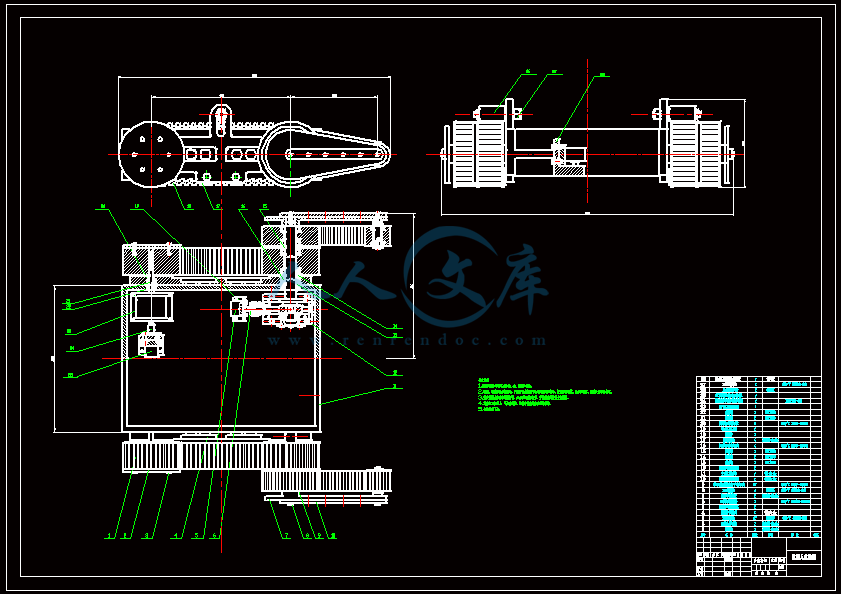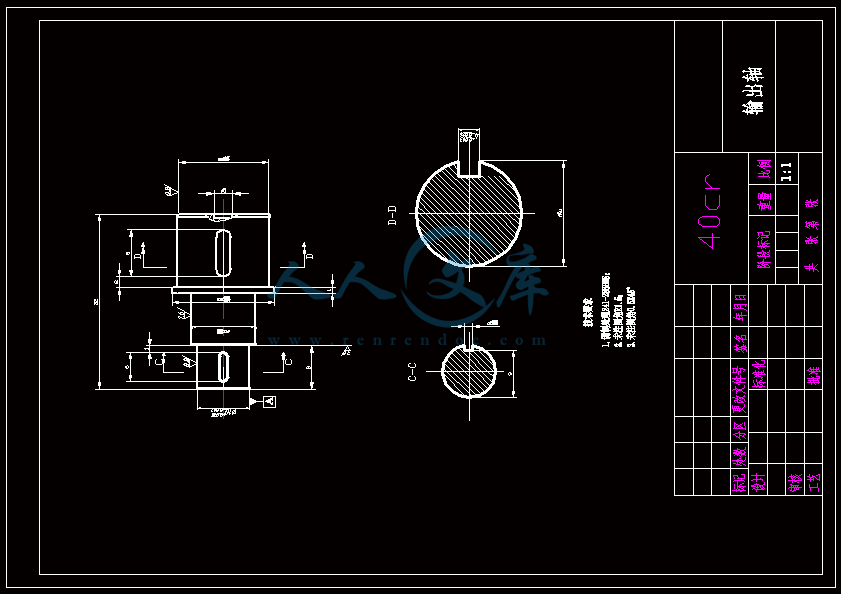井下搜救探测机器人结构设计【含CAD图纸、说明书】
收藏
资源目录

压缩包内文档预览:
编号:20991946
类型:共享资源
大小:3.29MB
格式:ZIP
上传时间:2019-07-18
上传人:机****料
认证信息
个人认证
高**(实名认证)
河南
IP属地:河南
50
积分
- 关 键 词:
-
含CAD图纸、说明书
结构设计【含
CAD图纸】
机器人结构设计【含
救援机器人结构设计【CAD图纸
设计说明书】
机器人结构设计【含CAD图纸
含CAD图纸
救援机器人结构设计【
救援机器人结构设计
- 资源描述:
-








- 内容简介:
-
System and Walking Gait Designfor Hexapod Search and Rescue RobotChen Yang-Yang and Huang YingyingAbstract In order to adapt to the complex disaster environment, this paper con-siders the system design of hexapod search and rescue robot. Such hexapod robot issuitable to different kinds of roads and obstacle, which can avoid to the short-comings of crawler robots. This hexapod search and rescue robot includes the sixfoot body, voice modular, obstacle avoidance and remote monitoring function.Based on the relationship between the center of gravity and the supporting polygon,the design of the hexagon robots walking gait is presented. The feasibility of thehexapod search and rescue robot is verified by the prototype experiment.Keywords Hexapod search and rescue robotThe design of walking gaitPrototype experiment1IntroductionRobotics is an important signs to measuring a countrys science and technologyinnovation and high level of manufacturing development. In 2016, “robot industrydevelopment plan” is promulgated by National Development and Reform Com-mission. As a main direction of robotics, search and rescue robot has receivedextensive attention in the past 10 years.C. Yang-Yang ()School of Automation, Southeast University, Nanjing 210096, Chinae-mail: yychenC. Yang-YangKey Laboratory of Measurement and Control of Complex Systems of Engineering,Ministry of Education, Southeast University, Nanjing 210096, ChinaH. YingyingSchool of Electronic Science and Engineering, Southeast University,Nanjing 2017514, Chinae-mail: 213131866 Springer Nature Singapore Pte Ltd. 2018Y. Jia et al. (eds.), Proceedings of 2017 Chinese Intelligent Systems Conference,Lecture Notes in Electrical Engineering 460,/10.1007/978-981-10-6499-9_62647Traditional search and rescue robots are mostly used the crawler robot due to itslow unit pressure on the ground and the traction reserve index on the weak carryingground. United States IRobot company gives Packbot 1 series of crawler robotswhich have finned track structure and first use the modular design. Thus such robotsbecome one of the classic design in the world. In order to develop the robotsenvironmental adaptability, Inuktuns VGTV 2 changes the track shape of thecrawler robot. However, crawler robots often stick and slip even worn in thepractice 3. Also, crawler robots have a larger size and thus have greater damage tothe ground when turning. There is a trend to use the hexapod robot to replace thecrawler type. Compared to the crawler type, the hexapod robot can cross throughmore rugged terrain and higher obstacles due to its discrete contact and it also hasgood mobility, energy consumption and independent isolation. In 1985, Robert B.McGhee et al. developed the adaptive suspension vehicle ASV 4 by using the legstructure, which can be regarded as one of the ancestors of six foot robot. NASAsJet Propulsion Laboratory presents ATHLETE 57 for aerospace cargo transport.The domestic research for walking robots start relatively late. Shanghai Universitydeveloped a spherical wall crawling robot 8. Shanghai Jiao Tong Universityconsidered the design of “six-feet octopus” rescue robot 9. Compared to theforeign application hexapod robot, there are also many technical challenges toovercome in the field of hexapod search and rescue robot at home.In this paper, we consider the system design of hexapod search and rescue robot.In order to achieve the search and rescue mission in the complex environment, wenot only give the hardware and software design of six-legged body, but also addvoice modular and remote monitoring function for human-computer interaction andobstacle avoidance by using ultrasonic and infrared sensors. Note that the robotscenter of gravity is unstable in the slope and step environment, we discuss the initiallayout of the leg at the time of slope travel and the six-legged sequence in the stepaccording the influence of the relationship between the polygon and the center ofgravity to the robot stability. Finally, two the prototype experiments are given toverify the feasibility of the gait in slope and step.2System DescriptionSince the search and rescue robot is required to have excellent adaptability for theenvironment, the design of the six-legged robot should not only have a flexiblesix-legged body, but also include automatically avoid or cross the obstacles andcommunicate with the operator. Therefore, the overall design for our search andrescue robot is listed as Fig. 1. In Fig. 1, the key of system is the embedded board,which includes the gait control algorithm of 18 electric machineries for servicingthe motion of six legs, obstacle avoidance algorithm according to the distancemeasurements by ultrasonic and infrared sensors, voice recognition module fordealing with the decision makers demands and image compression and transmis-sion supplying to the decision makers. From the hardware point of view to achieve648C. Yang-Yang and H. Yingyingthe above functions, we use the wrap-around layout for the six-legged robot, that issix legs are installed on the hexagonal vertices of octagon and each leg are con-trolled by three digital servos. The ultrasonic (HC-SR04) and infrared sensors arelocated at the front face of the robot and the WIFI camera is mounted at the top ofthe robot. The voice recognition module (LD3320 chip) and the video transmissionmodule (Qualcomm AR9331 chip) line to our main control module (Arduino Promini which core chip is ATmega168). The details can be found in Fig. 2.To make rational use of hardware resources, the responding software flow islisted in Fig. 3. At the beginning, the voice recognition module is in the standbystate. When it receives the command issued by the decision makers, the moduleuses the Voice. Read function to identify whether the instruction command matchwith the library, if not match the module keeps standby, else sends instruction to thesteering control module. Next, the gait algorithms are chosen based on the distancevalues coming from ultrasonic and infrared sensors and then drive the digital servo.At last, the software drives the WIFIcam to record the picture and translates thepicture to the decision markers. It should be emphasized that we determine the slopeor the step by using the different high position between the infrared sensor and theultrasonic sensor and their measurements.Fig. 1 Six-legged robot systemSystem and Walking Gait Design for Hexapod Search 649Fig. 2 Hardware designFig. 3 Software flow650C. Yang-Yang and H. Yingying3Gait ControlAccording to the difference of the supporting feet, the gait of six-legged robot candivide into the triangular, fluctuating and quadruped gait. Triangle gait is the mostflexible and fastest among the three gaits. Fluctuation gait is slowest but in goodstability while quadruped gait has intermediate performance between triangle gaitand fluctuation gait. Considering the practicability of robot, the six-legged robotuses the triangle gait when it moves on the flat ground. Noting that the movementon the ground can also be applied to slopes with the small slope angle 30, wefollow the triangle gait when the six-legged robot moves on some slopes with itsslope angle 0, the robot is stable, otherwise unstable. In the following,we will show the best swing angles of front legs according to the simulation resultsof iG.The wide and high of our prototype are 12 cm and 12 cm, respectively. Thegravity center of robot is 6 cm from the ground, and the distance from the toes tothe center is 14 cm when it stands. The details can be found in Fig. 7.In the slope state, the six-legged robot can improve the stability by changing theposition of the support point relative to the fuselage. It is hard to analyze therelationship between the stability and the position of the support point. Since theposition of the support point depends on the angle of the hip joint, we will show therelationship between the stability and the angle of the hip joint by simulations.Restricted by mechanical structure, the swing angle of each middle leg (that is 2,5) is limited in 60,60 while the swing angle range of each front/rear leg (thatis 1,4/3,6) is 30,90. Taking the triangle formed by 2,4,6 as a example,Figs. 8, 9 and 10 show 2,4G,4,6Gand 6,2G, respectively. From thesepictures, one can see that the best swing angles of legs 1w=6w=15,2w=5w=30and 3w=4w=45.Fig. 7 Prototype of robotSystem and Walking Gait Design for Hexapod Search 6533.3Step Gait DesignWhen the six-legged robot crosses the step, the quadruped gait is used. In thequadruped gait, the robot divides the six feet into three groups, that is the front legs(that is 1,4), the middle legs (that is 2,5) and the rear legs (that is 3,6). The threegroups are rotated in the order such the front legs, the middle legs and the rear legs.The phase diagram of the quadruped gait is shown in Fig. 11. From this picture, onecan see that there are always four legs in the support phase at one time. During thegait cycle, the support phase occupies 2T/3 and the swing phase occupies T/3,which means the coverage factor is 2/3.Fig. 8 Plot of 2,4GFig. 9 Plot of 4,6G654C. Yang-Yang and H. YingyingWhen the six-legged robot moves in the quadruped gait, the worst body stabilityappears in the situation that the front or hind legs lift up. Let the front legs in theswing phase as a case. If the middle and rear legs are in the support phase robot andthe quadrilateral consisting of four vertices corresponding to legs cannot exceed thecenter line of the body, then the robot body is stable (see Fig. 12). From abovediscussion, the step gait design is given as follows:(a) Front leg swings to the head, middle foot remain intact, and rear foot rotates totail in support phase to promote the body forward;(b) Front foot down, middle foot rotates to tail in support phase to promote theforward, and rear foot swings to the head;(c) Front foot rotates to tail in support phase to promote the body forward, middlefoot swings to the head, and rear foot down to support.Fig. 10 Plot of 6,2GFig. 11 Quadruple gaitphase diagramSystem and Walking Gait Design for Hexapod Search 6554Experimental ResultsIn this section, two experimental results are given. One is the movement of pro-totype on the outdoor slope, the other is the movement of prototype on the steps.In case 1, the slope angle is about 30 and its height is less than 1 cm that has noeffectonthesix-leggedrobot.Theinitialanglesofsixlegsare1w=6w=15, 2w=5=30, 3w=4w=45. The movement of prototype onthe outdoor slope is given in Fig. 13. From this picture, one can obviously see thatour prototype robot can move on the outdoor slope smoothly and rapidly.In case 2, we use the table to build a step such that the step height is 3 cm and itswidth 5 cm. The movement of prototype on the steps is shown in Fig. 14. From thispicture, it is obvious that our prototype robot can cross the steps easily.Fig. 12 Six-foot robotssupport polygonsFig. 13 The movement on the outdoor slope656C. Yang-Yang and H. Yingying5ConclusionThis paper presents the software and hardware design of the six-legged robot. Wegive experimental results for proving the gait design. In ongoing research, we willdevote to the feedback control of the gaits.Acknowledgements This work is supported by National Natural Science Foundation (NNSF) ofChina under Grant 61673106, Natural Science Foundation of Jiangsu Province under GrantBK20171362, the Fundamental Research Funds for the Central Universities and in part by aProject Funded by the Priority Academic Program Development of Jiangsu Higher EducationInstitutions.References1. Yamauch IB. Packbot: a versati
- 温馨提示:
1: 本站所有资源如无特殊说明,都需要本地电脑安装OFFICE2007和PDF阅读器。图纸软件为CAD,CAXA,PROE,UG,SolidWorks等.压缩文件请下载最新的WinRAR软件解压。
2: 本站的文档不包含任何第三方提供的附件图纸等,如果需要附件,请联系上传者。文件的所有权益归上传用户所有。
3.本站RAR压缩包中若带图纸,网页内容里面会有图纸预览,若没有图纸预览就没有图纸。
4. 未经权益所有人同意不得将文件中的内容挪作商业或盈利用途。
5. 人人文库网仅提供信息存储空间,仅对用户上传内容的表现方式做保护处理,对用户上传分享的文档内容本身不做任何修改或编辑,并不能对任何下载内容负责。
6. 下载文件中如有侵权或不适当内容,请与我们联系,我们立即纠正。
7. 本站不保证下载资源的准确性、安全性和完整性, 同时也不承担用户因使用这些下载资源对自己和他人造成任何形式的伤害或损失。

人人文库网所有资源均是用户自行上传分享,仅供网友学习交流,未经上传用户书面授权,请勿作他用。
 川公网安备: 51019002004831号
川公网安备: 51019002004831号